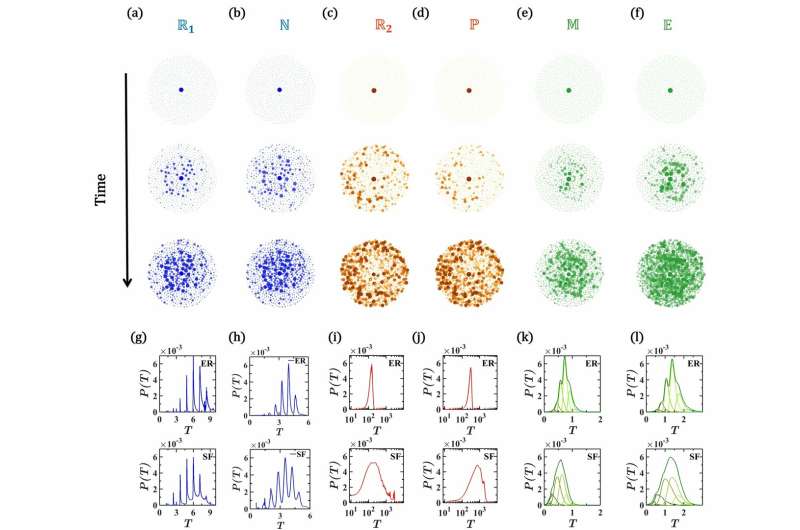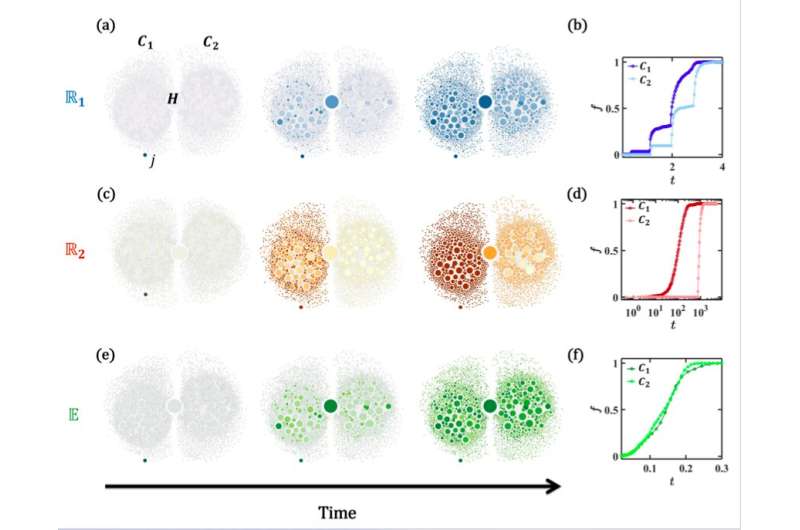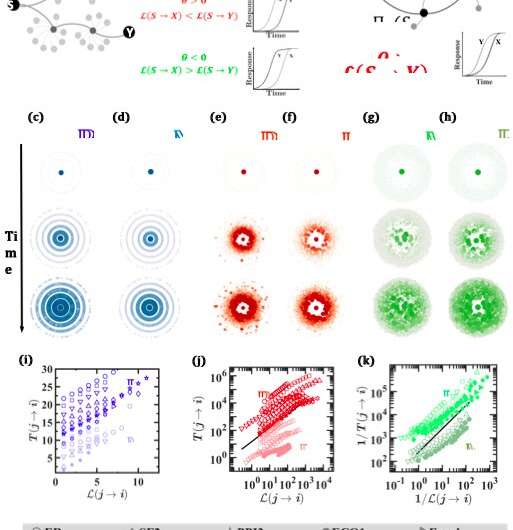February 22, 2019 feature
A new framework to predict spatiotemporal signal propagation in complex networks

Past studies have found that a variety of complex networks, from biological systems to social media networks, can exhibit universal topological characteristics. These universal characteristics, however, do not always translate into similar system dynamics. The dynamic behavior of a system cannot be predicted from topology alone, but rather depends on the interaction of a network's topology with the dynamic mechanisms that determine the relationship between its nodes.
In other words, systems with very similar structures can exhibit profoundly different dynamic behaviors. To achieve a better understanding of these observations, a team of researchers at Bar-Ilan University and the Indian Statistical Institute have recently developed a general theoretical framework that could help to systematically link the topology of a network with its dynamic outcome, particularly in the context of signal propagation.
"Complex networks are all around us, from social, to biological, neuronal and infrastructure networks," Baruch Barzel, one of the researchers who carried out the study, told Phys.org. "Over the past two decades, we have come to learn that despite this diversity of fields, the structure of these networks is highly universal, with different networks sharing common structural features. For example, practically all these networks—social, biological and technological—are extremely heterogeneous, with a majority of small nodes that coexists with a minority of highly connected hubs."
The framework developed by Barzel and his colleagues links the topology of a network to the observed spatiotemporal spread of perturbative signals across it. This ultimately allows the researchers to capture the network's role in propagating local information.
"The question that intrigues us in the lab is: Do these similar structures also hint at similar dynamic behavior?" Barzel said. "For instance, if Facebook and our sub-cellular genetic networks are both connected by hubs, does this mean they will exhibit similar behavior? In simple terms—does universality in structure translate into universality in dynamic behavior?"

The analyses carried out by the researchers suggest that the relationship between a system's structure and its dynamic behavior is based on balance. On the one hand, despite the shared structural characteristics, different networks may behave in profoundly different ways. On the other, these diverse behaviors are rooted in a universal set of mathematical principles, which could help to classify systems into universal classes of potential behavior.
"In an analogy, you can think of a falling rock and an eccentrically orbiting comet," Barzel explained. "They represent extremely different phenomena, yet Newton's laws show that they are both governed by the same fundamental equation of gravity. In our case, we show that the diverse dynamic behaviors observed across potentially similar networks, can be predicted by a set of universal principles that govern the laws in which network structure translates into network dynamics."
Barzel and his colleagues started off by trying to define the word "behavior." Their paradigm, which is based on several years of research, is based on the notion that while a network maps the patterns of connection between its nodes, its behavior can be conveyed as patterns of information flow, referred to as signal propagation.
For example, an epidemic that spreads across social ties could be viewed as information propagating in the form of viruses. Similarly, according to their framework, a local failure of a power component that ultimately results in a major blackout could be seen as information realized in the form of load perturbations, while a gene activating a genetic pathway represents biochemical information travelling between sub-cellular components.
"If you think of the signals (viruses, load perturbations, genetic activation, etc.) as abstract cars, then the network is their underlying road map," Barzel said. "A very complex and heterogeneous map, indeed, that supports the propagation of signals between a source node and its target. Now, we all know that the same road network can exhibit highly distinctive traffic patterns under different conditions. In analogy—the same network can lead to very different rules for the propagation of signals."

According to Barzel, in an analogy that describes signals as cars and the networks themselves as road maps, their framework could be seen as a "network GPS." This "GPS system" can predict how much time it will take for signals to travel across the network (e.g. how long it would take for the virus to infect people in a social group, for a blackout to occur after an initial power failure, or for a gene to activate a genetic pathway).
"A GPS translates a static road network into a dynamic prediction of travel times by breaking it down to segments, and estimating the time required to flow through each segment," Barzel explained. "We do the same here, using mathematical tools developed in our lab to estimate the signal lag-time at each network component. By piecing the puzzle together, we can then predict the spatiotemporal propagation through the entire network."
Taking into consideration several nonlinear dynamic models, the researchers found that signal propagation rules can be categorized into three highly distinctive dynamic regimes. These three regimes are characterized by different interplays between network paths, degree distributions and dynamics of interaction between network nodes.
"Statistical physics is a well established field that helps us map how microscopic particle interactions. e.g. between water molecules, lead to the system's macroscopic observed behavior, e.g. fluid, transparent etc.," Barzel said. "Our paradigm takes these tools to a whole new level: the particles are genes, neurons, routers or human individuals, and their interactions are in the form of signal spreading. Systems driven by such particles/interactions are often deemed non-sciency, you cannot predict or even observe their behavior; they are just a random mess of unorganized mishmash. In contrast, what our (and others') work is exposing is that such a statistical physics of social, biological or technological systems, is in fact attainable, and that behind their seemingly diverse and unpredictable observations lies a deep universality that can help us predict their behavior."
The study carried out by Barzel and his colleagues offers a fascinating example of how physics and mathematical frameworks could help us to better understand complex systems of a markedly different nature. Classifying system interaction mechanisms into the three main regimes that they uncovered could allow researchers to systematically translate a system's topology into dynamic patterns of information propagation, ultimately predicting the patterns of behavior of a variety of systems.
"Our motto is: understand, predict, influence," Barzel said. "The next natural step in our research is 'influence'. Can we, for instance, use our predictions on propagation to mitigate an undesired spread, such as an epidemic or a power failure cascade. For example, using strategically timed interventions in which we shut down, say 15 percent, of the components to save the remaining 85 percent from overloading. Our GPS can help us project the spread and hence deign a smart intervention scheme."
More information: Chittaranjan Hens et al. Spatiotemporal signal propagation in complex networks, Nature Physics (2019). DOI: 10.1038/s41567-018-0409-0. www.nature.com/articles/s41567-018-0409-0
Journal information: Nature Physics
© 2019 Science X Network



















